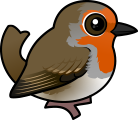Mind the Date
Crumbivore and Other Totally Real Bird Eating Terms
Whether you've seen birds of prey capture a snack on the wing, you've watched dabbling ducks feeding at the bottom of a pond, or you lure birds to your own yard by offering special snacks, eating is an interesting behavior to observe in birds. For this special edition of our Bird Terms series, we’re sharing a bunch of terms in rapid-fire style, letting you in on some truly special terminology related to birds and eating.
Breadcrumbivore
Also known simply as crumbivore, the breadcrumbivore is a bird that has fully adapted to foraging in human-dominated habitats, particularly those rich in abandoned carbs. Crumbivores specialize in locating, inspecting, and consuming bread-related debris, often with incredible speed and accuracy. While most birds will opportunistically consume a crust, breadcrumbivores actively seek them out in habitats including city centers, popular picnic spots, fast food parking lots, oceanfront promenades, and schoolyards right after recess. Fun fact: the collective noun for breadcrumbivore is crumble.
Pecknical Difficulties
Pecknical difficulties occur when a bird encounters an unexpected obstacle in the food acquisition process, often involving a stubborn shell, an oddly shaped seed, or a snack that requires more coordination than a bird is physically (or emotionally) prepared to handle. It is typically accompanied by visible frustration, muttered chirps, dramatic head tilts, and sometimes flinging the food item with unnecessary force. Common causes of pecknical difficulties include rocks that look like seeds, deterrent feeders like upside-down suet cages (usually meant to keep honest European Starlings from getting a bite), and pistachio nuts.

Beak-spresso
Beak-spresso refers to an extremely amped-up bird, often after consuming fermented berries or hyper-sweet nectar. Cedar Waxwings are practically synonymous with this condition. A bird suffering from beak-spresso displays jittery behavior, chaotic flight patterns, and a suspiciously wide-eyed stare. While usually a harmless, temporary situation, a beak-spresso incident may cause mild alarm among flockmates due to nonstop movement and a tendency to vocalize one's entire life story in one breath.
Wormageddon
Wormageddon is the chaotic, full-scale avian feeding frenzy that erupts after a heavy rain, when earthworms rise to the surface and all worm-loving birds lose their minds simultaneously. American Robins are especially prone to wormageddon situations. The phenomenon is marked by intense ground-pecking, high-stakes worm tug-of-war, and at least one bird screaming in triumph as it flies away with a 12-inch meat noodle dangling from its beak. Bonus term: a wormnado is when a single particularly wiggly worm causes four or more birds to chase it in circles like they're stuck in a cartoon.
Cheep Day
Cheep day is the one glorious, guilt-free day of the week when even the most seed-conscious birds go absolutely feral for junk food. Cheep days are all about indulgence, without a thought for typical diet staples and the importance of nutrition. The official motto for cheep day: "It's fine, I'll have sunflower seeds tomorrow".
Snackrobatics
Snackrobatics is the art (and sometimes accidental chaos) of birds performing aerial maneuvers to catch insects while in flight. This high-energy form of foraging combines precision, acrobatics, and hunger, all executed at warp speed. Birds who specialize in snackrobatics (think flycatchers, bee-eaters, and swallows) are not just eating, they’re performing (and a joy to watch!). Key techniques employed by snackrobatic specialists include the 'loop-n-gulp', the 'bug corkscrew', and the 'flutter-n-snatch'.
We love sharing real bird terms with you, but today, we’ve flapped off the rails with these totally fake, completely made-up terms just in time for April Fool's Day! Did we get you? Some of them sound real, don't they?






Comments
Leave a comment
Thank you!